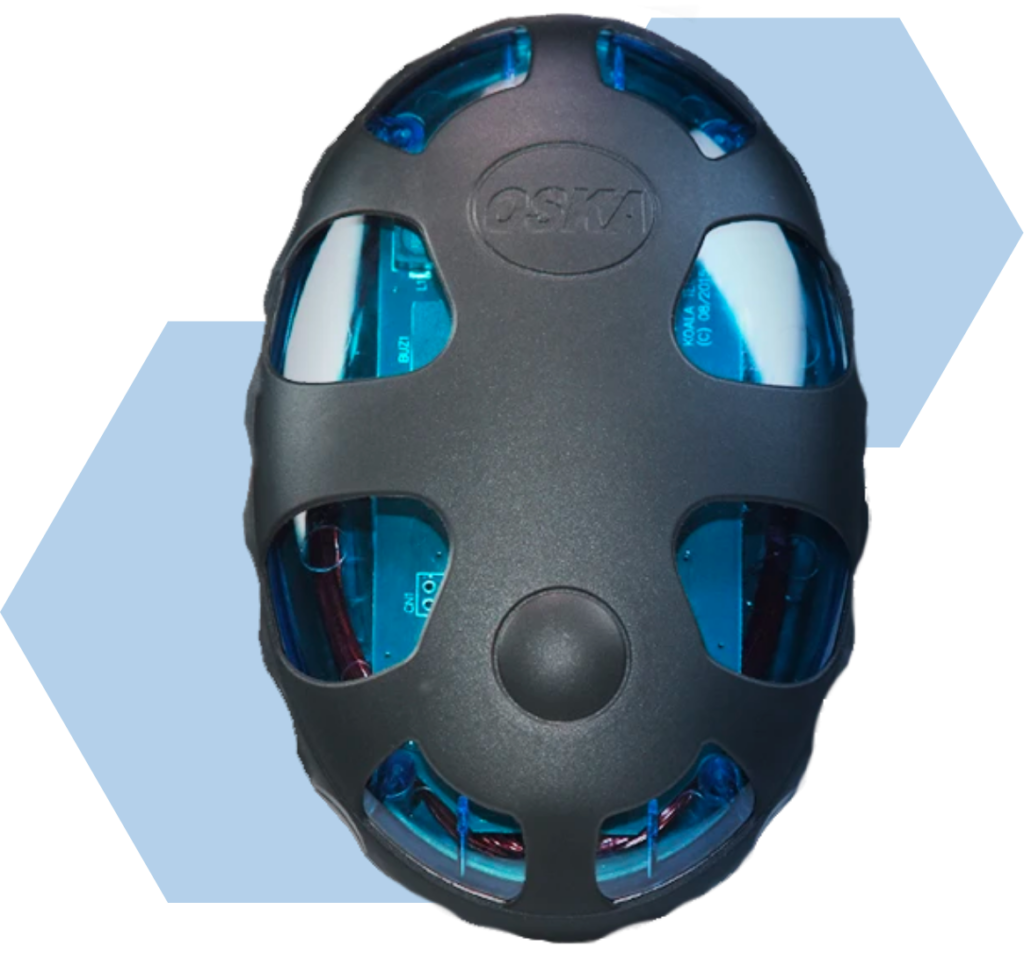Application
Oska Pulse is a clinically tested pain relief device that utilizes Pulsed Electromagnetic Field technology or PEMF, to help you start living with ease. It is suitable for use on all major types for muscle and tissue pain, including: back, shoulder, neck, knee, muscle and joint.
Back Pain

What is Back pain?
The human back is a complex structure consisting of bone, joints, nerves, muscle, tendons and ligaments surrounding the spinal cord. In itself back pain is not a disease. It is a symptom of a range of medical issues concerning one or more of the many parts that constitute the upper and lower back. Back pain is one of the more common complaints people of all ages endure. It is something most people experience in their lives, but its likelihood does increase with age.
Types of Back Pain?
Back pain is a broader term concerning discomfort anywhere along the spine, and in some cases extending down one or both legs.
Characteristics of back pain include:
- Ache, tension or stiffness
- Shooting or stabbing pain
- Pain that radiates down one or both legs
- Pain that worsens or restricts activity such as bending, lifting, standing, walking
- Pain that improves with reclining
- Limited movement at the chest and torso areas
- Tenderness with applied pressure along the spine
Causes
With the back being such a complex structure, the causes of back pain are not fully understood by traditional medicine. The pain often comes from the ligaments and surrounding muscles and not from any significant bone damage to the spine, where major trauma or injury has not occurred.
Many things can cause back pain – structural issues such as muscle strains or disc damage, lifestyle issues such as being overweight or sedentary and poor posture, and work or recreational activities where heavy lifting or sudden unnatural movement occurs. Specific medical conditions can also cause back pain including arthritis, sciatica, osteoporosis, ankylosing spondylitis, and spinal stenosis.
Neck Pain

What is Neck Pain?
The area known as the neck is actually part of the structure that makes up the spine; a complex arrangement consisting of bone, joints, nerves, muscle, tendons and ligaments surrounding the spinal cord. Like back pain, neck pain is one of the more common complaints people of all ages endure and in most cases, will subside after a few days.
There are various causes of neck pain, which is a symptom of a range of specific medical issues, rather than a disease in itself. When it strikes it can restrict and hinder all aspects of your life – family, social, work, and recreation. Without successful treatment, persistent neck pain can have detrimental effects on the state of mind and mental wellbeing.
Types of Neck Pain?
Neck pain is a broader term concerning discomfort anywhere in the neck area, and in some cases extending down to the upper back and shoulder.
Characteristics of neck pain include:
- Muscle ache or spasm
- Discomfort in the neck, upper back or shoulders
- Stiffness in the neck area
- A reduced range of motion or ability to turn the head
- Pain that radiates down one or both arms (and sometimes the legs)
- Headache
Causes
Neck pain has many different causes that range from accidental trauma and strain to degenerative disease and infection. It often derives from muscles and ligaments, rather than any significant bone damage where major trauma or injury has not occurred.
Pains associated with muscle and ligament strain or tension can be caused from a range of lifestyle factors including poor posture or sleeping position, or from accidental trauma at work or during recreational activity. Pain can also be attributed to general wear and tear of the bones that make up the neck and is considered a normal part of aging. Specific medical conditions that can also be the cause of pain include whiplash, meningitis, degenerative disc disease, cervical spinal stenosis, cervical spondylosis, herniated disc.
Knee Pain

What is Knee pain?
The human knee is the largest joint in the body. It bears a huge weight load as it facilitates movement and support which leaves it vulnerable to injury. Knee pain can stem from any part of – or combination of – the complex joint structure which is made up of bones, ligaments, tendons and cartilage. It is a common issue and is symptomatic of a range of structural problems and underlying medical conditions – it is not simply a condition in itself, but rather a generalized term relating to a number of ailments with differing timeframes and prognosis for recovery.
When knee pain strikes it can restrict and hinder all aspects of your life – family, social, work, and recreation. Without successful treatment, persistent pain can have detrimental effects on the state of mind and mental well being.
Types of Knee Pain?
Generally speaking, knee pain is characterized by discomfort in the knee often accompanied by stiffness.
Characteristics of knee pain include:
- Bruising
- Clicking
- Locking
- Unable to fully straighten
- Unable to apply weight or ‘giving way’
Causes
The most common causes of knee pain are sprained or torn ligaments, tendon and cartilage from sudden injury or overuse. Fractures and dislocations can also cause pain in the knee area.
While physical activity levels and frequency can determine likelihood and severity of knee pain, other factors such as obesity and aging also play a part. Specific medical conditions relating to arthritis – septic arthritis, gout, rheumatoid arthritis, and osteoarthritis – are another major cause of pain in the knee.
Muscle Pain

What is Muscle pain?
With 640 to 850 muscles in the human body, depending on how they are grouped, most people will experience muscle pain at some point in their lives. With muscle tissue in every section of the body – muscle pain can literally strike anywhere.
The pain felt by injured or damaged muscles can be caused by a number of reasons including strains and tears. When muscle pain is widespread throughout the body at multiple sites, it is usually indicative of either infection or a specific illness.
Types of Muscle Pain?
Muscle pain is a generalized term for discomfort in the muscle tissue.
Characteristics include:
- Muscle stiffness or tenderness
- External bruising and/or swelling
- Restriction in movement
- Reduced strength
Causes
Muscle pain is often caused by injury or trauma such as strains and bruising. Overuse through sustained or too often repeated physical exercise is another major cause of muscle pain. Stress and tension to individual muscles or groups of muscle also will cause discomfort, as will exertion to areas of muscle that are not used often such as in sporadic lifting of heavy items.
In some cases, muscle aches and pains are directly related to specific medical conditions or infections, often with widespread pain throughout the body. Some examples include fibromyalgia, influenza, autoimmune diseases, thyroid conditions and chronic fatigue syndrome.
Joint Pain

What is Joint pain?
There are 360 joints in the human body, the points at which any bones meet to allow the skeleton to move. When damage occurs at any of these sites, either from injury or ongoing illness, a degree of discomfort or pain follows.
While any joint can be affected, especially with degenerative disease, most commonly the major joints – knee, back, shoulder, hips, elbow, wrist, knuckles and ankle – are the ones that cause pain. In some cases it can be so widespread and severe that simple daily tasks become near impossible.
Types of Joint pain?
Joint pain is a generalized term for discomfort at the joint sites.
Characteristics of knee pain include:
- Swelling
- Stiffness
- Restriction of movement
- Aching and a feeling of warmth at the site
- Changes in the degree of severity throughout the day
Causes
Common causes of joint pain include injury from sprains and strains in the affected area and overuse during physical activity. These types of injuries usually last a relatively short duration and improve rapidly with rest.
Joint pain caused by illness and infection is also common including Mumps, influenza, hepatitis, fibromyalgia, sarcoidosis and rickets. Ongoing joint pain, especially as people age, may be caused by various rheumatic conditions such as arthritis, osteoarthritis, lupus and gout.
Shoulder Pain

What is Shoulder pain?
The shoulder is a set of ball-and-socket joints that combine with tendons and muscles to allow a wide range of motion in the arm. The shoulder is made up of three bones: the upper arm bone (humerus), the shoulder blade (scapula), and the collarbone (clavicle).
Shoulder pain can be caused by injuries brought about by performing manual labor, playing sports, or even by repetitive movement. In some cases, certain diseases in other parts of the body can bring about pain that travels to the shoulder.
Types of Shoulder pain?
Shoulder pain is a generalized term for discomfort at the shoulder area.
Characteristics include:
- Swelling
- Stiffness
- Reduced function in your shoulder, arm, and/or hand
Reduction or loss of mobility - A clicking or snapping sensation in the area
Causes
While most shoulder pain are caused by injuries from strenuous physical activities, it is also common to have cases not related to such causes. Among the common other causes are diseases like arthritis, tendonitis, bursitis, or frozen shoulder.
It is also possible to experience shoulder pain from causes that are not related to the shoulder area at all. Example of these are spinal issues, and sometimes, even an impending heart attack.

How can OSKA Pulse help in your pain?
Oska Pulse utilizes Pulsed Electromagnetic Field therapy (PEMF) which has been used in the medical community for over 60 years. PEMF uses low level electromagnetic waves that target the source of various types of pain, encouraging recovery at a cellular level, speeding up the natural healing processes of the body. Oska Pulse can be used complementary to other treatments as part of an overall management plan, or as a stand-alone therapy to soothe muscles and relieve pains.


